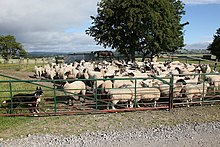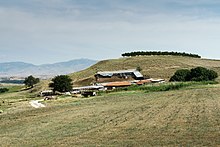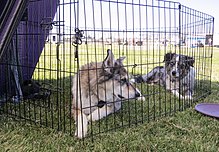
In livestock agriculture and the meat industry, a slaughterhouse, also called an abattoir, is a facility where livestock animals are slaughtered to provide food. Slaughterhouses supply meat, which then becomes the responsibility of a meat-packing facility.

In agriculture, fences are used to keep animals in or out of an area. They can be made from a wide variety of materials, depending on terrain, location and animals to be confined. Most agricultural fencing averages about 4 feet (1.2 m) high, and in some places, the height and construction of fences designed to hold livestock is mandated by law.

The Surin Elephant Round-up is a cultural festival held every year in Surin Province, Isan, Thailand. Usually the event is organized during the third week of November on the weekend. The festival has its origins in the royal hunts which were conducted in Surin Province during medieval times. The indigenous residents of Surin, the Kuy, have been traditional practitioners of corralling elephants and training them as working animals. When the Ayutthaya Kingdom came into power these hunts were converted into a public extravaganza and wild elephants were replaced with tame ones. The festival, in its contemporary form, was first organized in the 1960s when civil war in Cambodia and the steady decline in economic value of elephants forced the elephant handlers (mahouts) to seek occupations in the entertainment and tourism industry.

A sty or pigsty is a small-scale outdoor enclosure for raising domestic pigs as livestock. It is sometimes referred to as a hog pen, hog parlor, pigpen, pig parlor, or pig-cote, although pig pen may refer to pens confining pigs that are kept as pets as well. Pigsties are generally fenced areas of bare dirt and/or mud. "Sty" and "pigsty" are used as derogatory descriptions of dirty, messy areas, the word sty deriving from the Proto-German stijan meaning filthy hovel. There are three contributing reasons that pigs, generally clean animals, create such a living environment:

Kraal is an Afrikaans and Dutch word, also used in South African English, for an enclosure for cattle or other livestock, located within a Southern African settlement or village surrounded by a fence of thorn-bush branches, a palisade, mud wall, or other fencing, roughly circular in form. It is similar to a boma in eastern or central Africa.

A yard is an area of land immediately adjacent to one or more buildings. It may be either enclosed or open. The word may come from the same linguistic root as the word garden and has many of the same meanings.
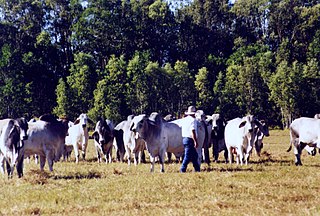
In Australia, a stockman is a person who looks after the livestock on a station, traditionally on horse. It has a similar meaning to "cowboy". A stockman may also be employed at an abattoir, feedlot, on a livestock export ship, or with a stock and station agency.
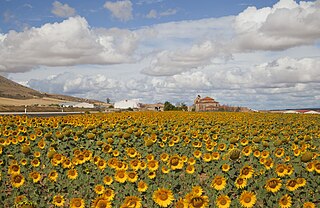
In agriculture, a field is an area of land, enclosed or otherwise, used for agricultural purposes such as cultivating crops or as a paddock or other enclosure for livestock. A field may also be an area left to lie fallow or as arable land.
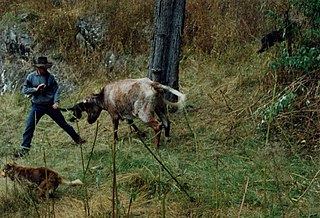
A muster (Au/NZ) or a roundup (US/Ca) is the process of gathering livestock. Musters usually involve cattle, sheep or horses, but may also include goats, camels, buffalo or other animals. Mustering may be conducted for a variety of reasons including routine livestock health checks and treatments, branding, shearing, lamb marking, sale, feeding and transport or droving to another location. Mustering is a long, difficult and sometimes dangerous job, especially on the vast Australian cattle stations of the Top End, 'The Falls' (gorge) country of the Great Dividing Range and the ranches of the western United States. The group of animals gathered in a muster is referred to as a "mob" in Australia and a "herd" in North America.

A boma is a livestock enclosure, community enclosure, stockade, corral, small fort or a district government office, commonly used in many parts of the African Great Lakes region, as well as Central and Southern Africa. It is particularly associated with community decision making. The word originally may be from Bantu or Persian, and it has been incorporated into many African languages, as well as colonial varieties of English, French and German.

The Portland Expo Center, officially the Portland Metropolitan Exposition Center, is a convention center located in the Kenton neighborhood of Portland, Oregon, United States. Opened in the early 1920s as a livestock exhibition and auction facility, the center now hosts over 100 events a year, including green consumer shows, trade shows, conventions, meetings and other special events. Located on the north side of Portland near Vancouver, Washington, it includes the northern terminus for the Yellow Line of Portland's light-rail transit system and has connections to TriMet Bus Line 11-Rivergate/Marine Dr.

Woburn Safari Park is a safari park located in Woburn, Bedfordshire, England. Visitors to the park can drive through exhibits, which contain species such as southern white rhino, elephants, tigers and black bears. It is part of the estates of the Duke of Bedford that also includes Woburn Abbey and its 3,000-acre (1,200 ha) deer park. The Safari Park itself covers 360 acres (150 ha).

The Union Stockyards of Omaha, Nebraska, were founded in 1883 in South Omaha by the Union Stock Yards Company of Omaha. A fierce rival of Chicago's Union Stock Yards, the Omaha Union Stockyards were third in the United States for production by 1890. In 1947 they were second to Chicago in the world. Omaha overtook Chicago as the nation's largest livestock market and meat packing industry center in 1955, a title which it held onto until 1971. The 116-year-old institution closed in 1999. The Livestock Exchange Building was listed on the National Register of Historic Places in 1999.

The raising of domestic sheep has occurred in nearly every inhabited part of the globe, and the variations in cultures and languages which have kept sheep has produced a vast lexicon of unique terminology used to describe sheep husbandry.

An animal pound is a place where stray livestock were impounded. Animals were kept in a dedicated enclosure, until claimed by their owners, or sold to cover the costs of impounding.
An equestrian facility is created and maintained for the purpose of accommodating, training or competing equids, especially horses. Based on their use, they may be known as a barn, stables, or riding hall and may include commercial operations described by terms such as a boarding stable, livery yard, or livery stable. Larger facilities may be called equestrian centers and co-located with complementary services such as a riding school, farriers, vets, tack shops, or equipment repair.

Elephantstay is a non profit enterprise under the Prakochabaan Foundation in Ayutthaya, Thailand. The mission of the enterprise is educate people about the importance of elephants in Thai history and culture as well as caring for elephants.

The Karlsruhe Zoo is a city garden with a zoo in the southwest of Karlsruhe, Germany. It also encompasses the outer area; Tierpark Oberwald in the southeast of the city. The main area totals 22 hectares, and the Oberwald Zoo has an area of 16 hectares. A total of around 3000 animals of over 240 species live at the Zoologische Stadtgarten Karlsruhe. The city garden is located north of the Karlsruhe Hauptbahnhof and south of the Karlsruhe Congress between the Karlsruhe districts of Südstadt and Südweststadt. The zoo was opened in 1865, making it one of the oldest zoos in Germany. The city garden and zoo form a common, enclosed area and cannot be visited separately.

A paddock is a small enclosure for horses. In the United Kingdom, this term also applies to a field for a general automobile racing competition, particularly Formula 1.
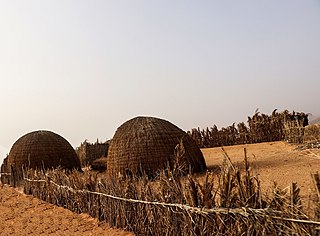
A zariba is a fence which is made of thorns. Historically, it was used to defend settlements or property against perpetrators in Sudan and neighboring countries such as Chad and further south in Democratic Republic of the Congo. An example would be as a pen to protect cattle and other livestock from predators such as lions, albeit often unsuccessfully.
